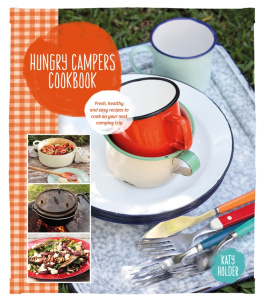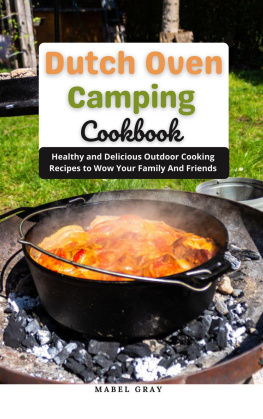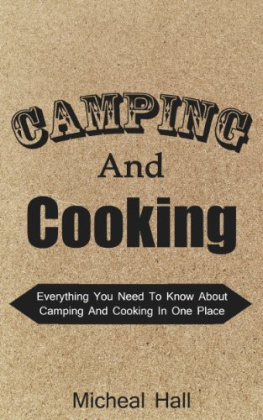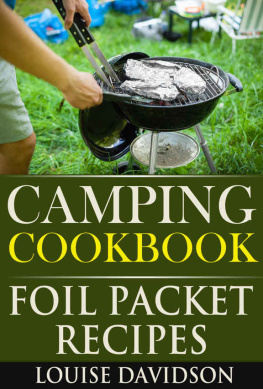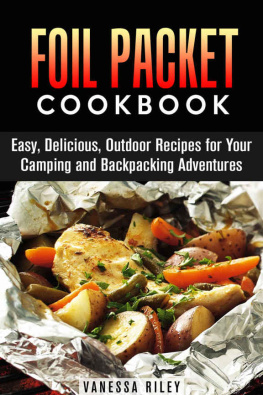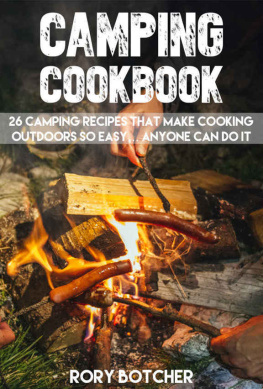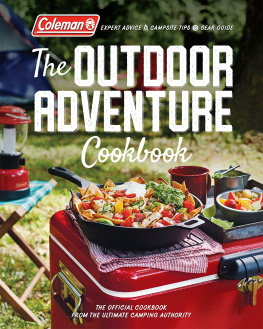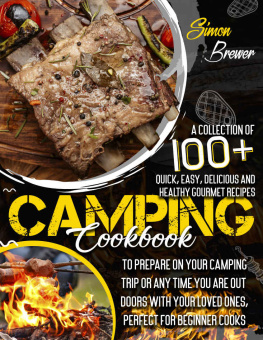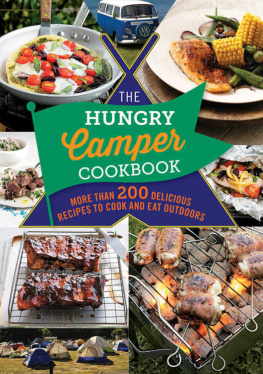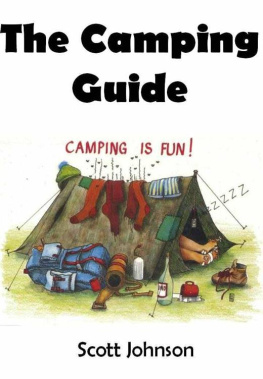This book is dedicated to my own big and little hungry campers, Alex, Max and Jack.
Thanks for munching your way through this book and for so many fun camping adventures.
CONTENTS
INTRODUCTION
My camping career started at age six, when I camped out in the back garden of our London home during the summer holidays. I was so excited to put up my tiny orange ridge tent, light a small fire and heat up some beans and bake a few potatoes. Snuggled down in my sleeping bag, reading by the light of a torch seemed like the ultimate adventure and I havent looked back since.
We progressed to family camping holidays every summer, where my siblings and I revelled in the freedom the campsite gave us. As an adult, I have camped all over the world and have now introduced my love of camping to my two sons fortunately my husband was already a fan. We always travel to our campsite by car and this book has been written with this in mind, as it allows us to carry additional utensils and equipment to make our trips a little easier and more luxurious.
The Hungry Campers Cookbook is for everyone who goes camping, or aspires to go camping, and who wants to eat delicious camp-made food. Every recipe has been cooked at a campsite far from home but will also work in a domestic kitchen. With a little forethought and preparation, eating under the stars can be as good, if not better, than any meal eaten at home.
Katy Holder
PACKING YOUR COOL BOX OR ESKY
One of the biggest joys of camping is that it allows you to get back to basics and live a simple lifestyle for a while. The drawback of this, however, is that you cant just reach into the refrigerator when you want cheese for your sandwich or an ice cold beer.
Plus, you need to give careful consideration to how you will store your food to prevent it going off. The cool box that you use for drinks at your Sunday afternoon barbecue isnt going to cut it for a three- or four-day camping trip, as the walls arent sufficiently insulated. Invest in a proper cool box, or esky, and ice packs, which are all available from a camping or outdoor store.
Giving a little consideration to how you pack your chilled food before you go will not only help to keep your food cold, but also make finding things and keeping them in good condition easier.
- Freeze any milk, juice and bottles of water youre going to take with you these will double as ice packs and defrost over the first day or two.
- Freeze packets of bacon, sausages and meat before you leave. Not only does this make them last longer without going off, but the frozen packets also act as additional ice packs.
- Put any snacks or meals you are preparing in advance (see ), into airtight containers, then freeze the meals. Takeaway containers work well for this and can be stacked neatly in your cool box they will also do a similar job to an ice pack for the journey. Dont forget to remove the one you want to eat for dinner so it defrosts in time!
- Pack cheeses into shallow storage containers to prevent them getting squashed. Do the same with packets of meat. Keep things well wrapped to prevent crosscontamination.
- Many butchers will vacuum pack meat for a small charge, so ask about this when buying your meat. Although the meat will still need to be stored in a cool box, it should last for an extra three to four days longer than un-sealed meats. If you have some fresh meat that isnt going to last another day, cook it then chill it and eat it the next day for lunch.
- Use good-quality ice packs and leave room at the top of your cool box for a layer of them, as the cold air will sink down.
PACKING NON-PERISHABLE FOODS
Packing all of the items not stored inside your cool box also requires a little forethought and planning, as space at the campsite is often at a premium. You can also save yourself a lot of time and energy when you arrive, if you keep in mind the following tips.
- Save a storage container of small sachets of tomato ketchup, soy sauce, sugar, salt and other condiments that often come with takeaway meals for taking on weekend and shorter camping trips. For longer trips, its better to take regular bottles and jars as there is less packaging to dispose of.
- Write the contents on the top of your containers using a washable marker, as more often than not youll be rummaging in boxes to find things and the lid will be the easiest to spot. Stick white labels on the tops of spice jars to easily spot them in your food stocks.
- Think about decanting some ingredients into smaller containers before you leave home, based on how long you will be away and how many people you will need to feed. If you think you are going to make pancakes one morning, weigh out the flour and baking powder and put into an airtight container or re-sealable snack bag and label it so when you get to the campsite you know exactly what its for. Then all you have to do is add your milk and eggs and youre ready to cook.
- Although you could take a bottle of shopbought salad dressing, think about mixing some up before you go. If you dont use it all on your trip, it keeps well and you can always use it up at home. At its simplest, a dressing is just a combination of olive oil and vinegar one part vinegar to two or three parts oil and some salt and pepper. Throw in a peeled garlic clove and a teaspoon of mustard if you like.
ESSENTIAL FOOD ITEMS
Some of the recipes in this book include a dont forget tip to ensure you have all of the ingredients you need for the recipe to taste as good as it should. This usually relates to store cupboard ingredients that might be forgotten in a last-minute packing frenzy. When youre camping out in the bush you cant just pop out to the corner shop theres nothing worse than starting to cook a recipe and realising youve forgotten an important ingredient. Here, Ive suggested items that I usually pack. I dont have dedicated food for camping, instead I take from my kitchen cupboards so I know its fresh.
BUTTER I take a spreadable butter in a tub rather than the blocks wrapped in paper as it stores more efficiently and is less likely to be found melted at the bottom of the cool box.
BREAD, ROLLS AND PITA POCKETS Good to use for breakfast toast, to make sandwiches for lunches, to mop up curries and stews or to make or any of the kebabs.
BREAKFAST SPREADS Marmalade, Vegemite, jam, peanut butter and honey. Also useful to have if you make .
CAPERS AND OLIVES These two ingredients can instantly transform a recipe. I love them in salads, pasta sauces and dressings.
CEREALS As a general rule, I am opposed to eating sugary breakfast cereals, however, as a treat and for convenience every few camping trips I buy the selection packs or mini cereals available at most supermarkets. Not only do the kids love this treat, but I have an ulterior motive less washing up! I open the boxes and plastic inserts carefully at the top, then pour the milk straight in. The kids love the fun aspect of it and all thats left to wash up is a spoon.
CHEESE Pack a variety. I usually buy some pre-sliced to make preparing sandwiches easy and then a bag of grated cheese for using on pasta and pizza. And dont forget the decadent wheel of brie or camembert for the camp-fired .
CHUTNEY Great for a quick baste or marinade, chutney elevates a humble sandwich to something more special.
COLD MEATS Pack a selection of sliced ham, salami and chicken as well as sandwich fillings, they can be used for pizzas and .

